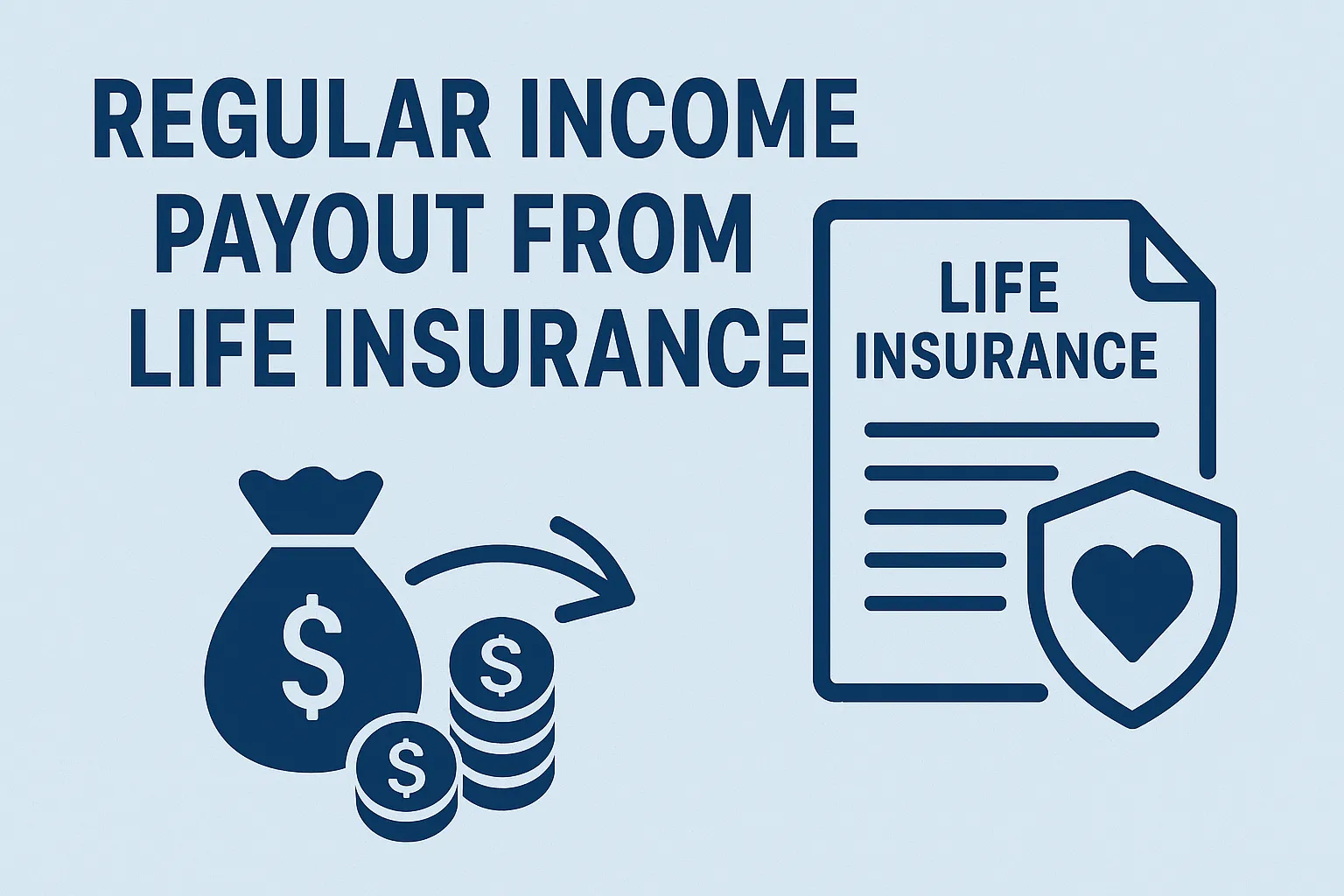Home / Life Insurance / Articles / Life Insurance General / Regular Income Payout from Life Insurance
Regular Income Payout from Life Insurance
Neviya LaishramNov 4, 2025
Share Post
Regular income from life insurance refers to the consistent sum you receive during or after the duration of your plan. In this regard, it provides guaranteed monthly, yearly, or lump-sum income depending on the terms of the plan. Typically, it can be used to replace or supplement missing income without exposure to market risks.

Contents
Key Takeaways
Guaranteed Income: Regular income provides guaranteed payouts.
Predictable Cash Flow: Beneficiaries receive steady payments to cover recurring expenses, reducing financial strain.
Low-Risk Investment: Most guaranteed income plans are designed to be low-risk. These plans adhere to strict regulatory guidelines and investment strategies to minimise risk exposure.
How Does a Regular Income Payout from Life Insurance Work?
In a life insurance policy where the beneficiary is to receive regular income payments, the death benefit will be paid out in equal amounts, monthly, quarterly, or annually, rather than all at once.
Under this approach, a steady and predictable income stream is available to cover regular expenditures, such as education, rent, or medical care.
In the event of the insured's death, the insurance company initiates these periodic payments over a specified number of years. This ensures that the family remains financially secure without the hassles of managing a huge lump sum.
Real-life Example
Mr Parimal, 40, buys a life insurance policy with a ₹1 crore sum assured. He opts to split the benefit equally:
₹50 lakhs as a lump sum
₹50 lakhs allocated for the monthly regular income
The income factor used is 10.09 per ₹1,000 of sum assured.
Regular Income Calculation:
₹50 lakhs × 10.09 ÷ 1,000 = ₹50,450/month
Outcome:
In case of a claim, Mr Parimal's nominee receives:
₹50 lakhs upfront as a lump sum
₹50,450/month as regular income for the chosen tenure
This ensures financial stability for the family without the stress of managing a large one-time payout.
Note: The figures shown are examples. Actual payouts may vary depending on the policy and insurer.
Regular Income Vs Lump Sum Payout: Key Differences
Choosing between regular income and lump sum payouts in life insurance depends on your financial goals, risk tolerance, and life stage. Here's a quick comparison:
Aspect | Regular Income | Lump Sum Payout |
|---|---|---|
Payout Style | Income in regular instalments | One-time full payout |
Ideal For | Retirement, passive income needs | Major expenses, asset purchase, debt repayment |
Liquidity | Steady cash flow over time | High immediate liquidity |
Financial Risk | Safer, less prone to mismanagement | High risk if not managed prudently |
Total Returns Access | Takes time to recover full value | Entire returns available at once |
Why Regular Income Payout Matters for Policyholders?
Here are the key advantages of regular income payout:
Guaranteed and Predictable Income: Regular income payout offers guaranteed payouts. These plans offer a steady income stream to cover everyday living expenses and provide financial stability.
Safer, Low-Risk Investment: These insurance policies are based on safe investments and regulated frameworks. Your capital remains intact, and profits are not affected by market falls.
Tax Efficiency: Premiums paid are eligible for tax deductions under Section 80C (up to ₹1.5 lakh) of the Income Tax Act. The maturity or death benefit is tax-exempt under Section 10(10D), subject to applicable terms and conditions.
Improved Financial Discipline and Security: Regular income payments from life insurance help make sure the money lasts longer, preventing any impulsive use of funds. This reduces financial strain and the possibility of financial burnout.
Customisable: Policyholders have the option of setting payout frequency, amount, and tenure as per the requirements of their family.
Summary
Regular income payout in life insurance ensures steady, predictable support for families, aligning with daily expenses. Unlike lump-sum payments, they provide long-term financial stability, ensuring your family's future is secure and their needs are met seamlessly.
Frequently Asked Questions
Below are some of the frequently asked questions on Regular Income Payout from Life Insurance
Are life insurance plans that offer regular income considered low-risk investments?
Yes, the life insurance plans that offer regular income generally involve low risk.
How do life insurance plans offer consistent income?
Life insurance plans invest your premiums in safe, low-risk instruments. Over time, the returns and savings accumulate and are paid out as regular income based on the plan’s terms, ensuring steady and reliable payouts.
How do I select the correct life insurance scheme for a regular income?
To choose the right life insurance plan for a regular income benefit, start by assessing your financial goals, whether it’s retirement, children’s education, or long-term stability. Visit the websites of multiple insurers and compare their plans based on payout options, flexibility, and coverage.
Why should policyholders choose regular income payouts in life insurance?
Regular income payouts provide consistent financial support for beneficiaries. This reduces the risk of mismanaging large sums of money. They are especially beneficial for households with regular expenses, such as education or rent.

Recent
Articles
Monthly Income Benefit in Life Insurance
Neviya Laishram Oct 30, 2025
Regular Income Payout from Life Insurance
Neviya Laishram Oct 30, 2025
Section 80D of the Income Tax Act - Life Insurance
Neviya Laishram Oct 30, 2025
Does Travel Insurance Cover Medical Expenses Abroad?
Team Acko Oct 28, 2025
Comprehensive vs. Basic Travel Insurance: What’s the Real Difference?
Team Acko Oct 28, 2025
All Articles
Want to post any comments?
ACKO Term Life insurance reimagined
ARN:L0072|*T&Cs Apply
Check life insurance


